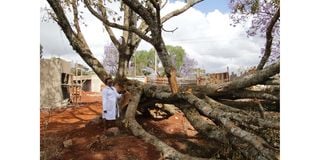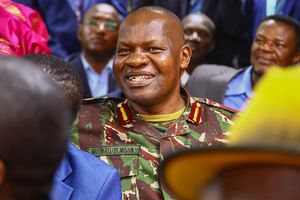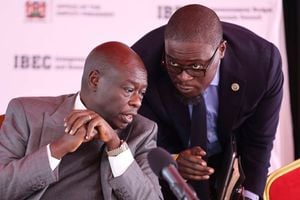Why elders must cleanse site of fallen ‘Mugumo tree’ at Ruring’u

National Museums of Kenya Nyeri curator Wambui Mwangi shows broken branches of a Mugumo tree that was planted by former President Jomo Kenyatta in 1963 at Ruring'u satdium in this photo taken on October 31, 2022.
What you need to know:
- The locals have been incensed by the contractor’s failure to consult before felling the tree, saying that he would have preserved the tree Uhuru Kenyatta planted five years ago at the construction site to mark the start of renovation work at the sports facility
- Kikuyu elders Monday met at the stadium and conducted a ritual at the site where the tree that had been planted by Uhuru, stood
- Project contractor George Kihoi of Comnet Technologies said he had stuck to the contract timelines given by his client
A storm has erupted at Ruring’u Stadium after the contractor uprooted a fig tree (Mugumo tree) that was planted by former President Uhuru Kenyatta, and a commemorative plaque to accommodate a new design.
The felling of the tree that holds cultural significance among the Agikuyu community has left locals furious. The locals have been incensed by the contractor’s failure to consult before felling the tree, saying that he would have preserved the tree Uhuru Kenyatta planted five years ago at the construction site to mark the start of renovation work at the sports facility.
Wambui Mwangi, a curator with the National Museums of Kenya who is attached to Nyeri, said such trees are not just meant for commemoration but they are also part of the national heritage and should be preserved for future generations.
"I just don’t understand how the contractor can make such an arbitrary decision knowing well that the tree was planted by the former Head of State to mark an important moment in history," wondered Wambui.
There has been a stand-off between local stakeholders and the project contractor on how to deal with three trees planted by three former heads of state; Jomo Kenyatta, Daniel Arap Moi, and Uhuru Kenyatta.
On Monday, Nation Sport established that two branches of the tree that was planted by Mzee Kenyatta in 1963 have since broken off. Wambui said the matter has not been reported to the National Museums of Kenya.
Kikuyu elders Monday met at the stadium and conducted a ritual at the site where the tree that had been planted by Uhuru, stood.
Mzee Mathenge wa Iregi and Kariuki Kabui said a major ceremony will be held “to cleanse the scene.” He warned the contractor against touching any of the fig trees.
They lit a fire at the site where the tree was uprooted and conducted prayers facing Mt Kenya.
"When something like this happens, elders will have to visit the area and decide what to do because something must be done," said Wairegi.
Project contractor George Kihoi of Comnet Technologies said he had stuck to the contract timelines given by his client.
"Work has to be done. We cannot have these back-and-forth fights over trees that are within the design of the stadium. You can’t have your cake and eat it. It is either the stadium or the trees," said Kihoi.
He said the design of the stadium had been changed from the original one, affecting the three trees.
Nyeri Central Deputy County Commissioner Joseph Mwangi said it was important for the contractor to consult the relevant authorities before uprooting the tree even if it was within the design .
"This is a matter that needs to be investigated. With proper consultations, there was a way to deal with it. I will take it up immediately to establish what happened," said the administrator.
The stadium has been under construction since 2017 when the government embarked on upgrading it to international standards.
The project has been marred by cash delays with various government departments engaging in blame game.
Phase one of the project was estimated to cost Sh287 million and is yet to be completed. It is 60 percent done.





